![]()
16 mm Lens Specifications
Focal Length: 16 mm (35 mm Equivalent Focal Length: 24 mm)
Maximum Aperture: f/1.4
Minimum Aperture: f/16
Lens Mount: Sony E Mount
Sensor Format: APS-C
Angle of View: 83.2°
Maximum Magnification: 0.10101 x
Minimum Focus Distance: 9.84″ / 25 cm
Optical Design: 16 Elements in 13 Groups
Diaphragm Blades: 9 Rounded
Focus Type: Autofocus
Image Stabilization: None
Filter Size: 67 mm (Front)
Dimensions: (W x L): 2.8 x 3.6″ / 72.2 x 92.3 mm
Weight: 14.29 oz / 405 g
MSRP: $449 USA
Website: https://www.sigmaphoto.com/
![]()
30 mm Lens Specifications
Focal Length: 30 mm (35 mm Equivalent Focal Length: 45 mm)
Maximum Aperture: f/2.8
Minimum Aperture: f/22
Lens Mount: Sony E
Sensor Format: APS-C
Angle of View: 50.7°
Maximum Magnification: 0.125 x
Minimum Focus Distance: 11.8″ / 29.97 cm
Optical Design: 7 Elements in 5 Groups
Diaphragm Blades: 7
Focus Type: Autofocus
Image Stabilization: None
Filter Size: 46 mm (Front)
Dimensions (W x L) 2.39 x 1.59″ / 60.71 x 40.39 mm
Weight: 4.9 oz / 140 g
MSRP: $280 USA
Website: https://www.sigmaphoto.com/
Introduction
Sigma lenses are rapidly becoming a go-to source for additional lens options that fit Canon, Nikon, and Sony digital cameras.
They seem to always measure up to the native lenses for these cameras in terms of build quality, sharpness (resolution), flare, distortion, chromatic aberration, and vignetting. The price is about the same as the native lenses for the three cameras.
In this article, I review two of the Sigma lenses. One is a 16 mm f/1.4 lens, and the other is a 30 mm f/2.8 lens. They have an E-mount, which is for Sony mirrorless cameras with APS-C sensors.
The 16 mm Lens
The 16 mm f/1.4 lens is an extreme wide-angle lens. It has a large aperture (f/1.4) which makes it ideal for wide-angle shots inside buildings or other structures.
APS-C sensors are smaller than “full-frame” (36 mm x 24 mm) sensors, so the 35 mm “equivalent” specification is always given, which for this lens, is 24 mm. The size of the APS-C sensor in the Sony A6000 camera that I used for this review is 23.5 mm x 15.6 mm. The APS-C sensor size varies a bit depending on the camera. What this means is that the APS-C sensor field of view with a 16 mm lens is the same (approximately) as with a 24 mm lens on the full-frame camera. You can calculate the full-frame equivalent easily. The formula is Equivalent = focal length + ½ focal length. So, for the 16 mm lens, it is 16 + 8 = 24 mm.
The f/stop is defined as the focal length divided by the diameter of the lens opening, so with this f/1.4 lens, 1.4 = 16 / d, and d = 16 / 1.4 = 11.43 mm. Note that this is not the diameter of the front or rear lens element. It is the diameter of the lens opening that is produced inside the lens. The lens opening is produced by a diaphragm that has several blades – in the case of this 16 mm lens, there are seven – which are arranged in a circle. The blades move to make the lens opening larger or smaller, depending on the exposure required. With this lens, when the lens opening is as large as it can get, the f/stop is 1.4.
The lens comes with a lens hood, shown below.

The 30 mm Lens
The 30 mm lens has an f/2.8 maximum aperture. Its 30 mm focal length results in an angle of view about half the size as from the 16 mm lens. The angle of view for a lens is α = 2 arctan d/2ƒ, where α is the angle of view, d is the width of the sensor, and ƒ is the focal length . Because the formula is trigonometric, the angle of view does not vary linearly with the reciprocal of the focal length (https://en.wikipedia.org/wiki/Angle_of_view). However, to simplify, the angle of view for lens “A” which is twice the focal length of another lens “B” is about 53% x “B”.
The f/2.8 aperture in the 30 mm lens gives you two f/stops less light than from the 16 mm f/1.4 lens. That is not so important outside in the sun, but it does make a difference inside where you are working with available light. The 16 mm lens is for landscapes and interiors, while the 30 mm lens would be good for portraits. However, even 30 mm lenses are considered “wide-angle”, and wide-angle lenses cause a certain amount of perspective distortion, meaning that facial features that are closer to the lens, such as the nose, will appear larger than they should. The remedy for this is simple. Place the subject off to one side rather than in the center, and don’t take the photo too close to the subject. Stand back, say, about 4 feet at the closest.
Here is a list of f/stops with the difference between each f/stop and the next being one stop: f/1.4, f/2, f/2.8, f/4, f/5.6, f/8, f/11, f/16, f/22. Changing from one f/stop to the next requires either halving or doubling the exposure setting, depending on whether you are increasing the f/stop or decreasing it. The 16 mm lens has a range of eight f/stops while the 30 mm lens has six.
Both of the lenses in this review are “prime”, which means they are not zoom lenses with multiple focal lengths. They have a fixed focal length. The reason prime lenses are useful is that they are sharper than zoom lenses. With a zoom lens, some of the lens elements move when the lens is zoomed. Since this is not a perfect process, the zoom lens image sharpness suffers a bit. Not much, but it is measurable.
In Use
I took the Sigma 16 mm lens to Europe on vacation. It turned out to be a superb lens for photographing wide-angle views of landscapes there, as well as some interiors.
Here is a shot of the stairwell of the Grand Hotel in Amsterdam. I shot it with the lens set to f/2.8 and the camera set to ISO 800, 1/60th second. This was the best compromise between aperture, ISO, and shutter speed. I don’t like to use a shutter speed less than 1/60th second, even with image stabilization, because a slower shutter speed produces image blur.
I always create RAW image files with the Sony A6000 because it allows image editing in Lightroom and Photoshop without artifacts that would be produced by editing a JPG and resaving it as JPG. I save the edited RAW images as 16 bit TIFs. This gives maximum dynamic range and no JPG artifacts. For this article, however, I had to save the TIFs as a JPGs for the sake of reader download speed.
The wide-angle view from this lens allowed me to get the entire stairwell in the photograph, and field-of-view is very important when you are in a photogenic location.
![]()
Here is a blow-up of the center of the image. You can see detail in the inlaid marble floor and in the banister column.
![]()
In St. Petersburg, Russia, I took this photo from the stern of our cruise ship. The camera was set to ISO 100 and a shutter speed of 1/750th second. The 16 mm lens was set to f/8.
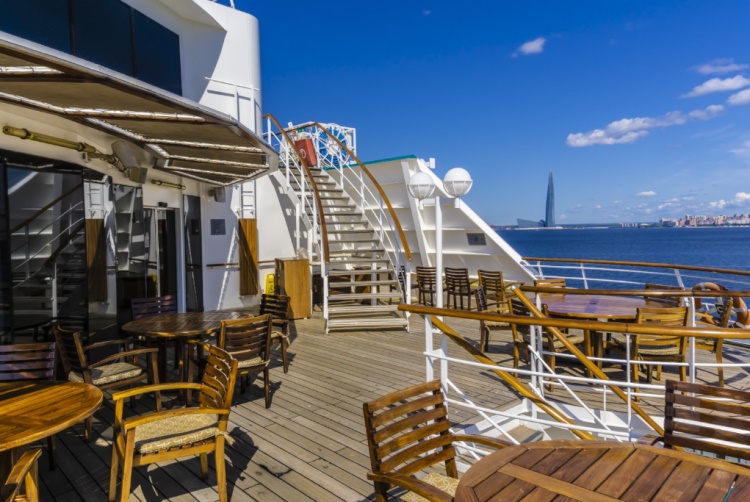
I took two photos here. One was the photo shown above, and the second one was taken with the camera moved to view towards the right, with a slight overlap between the two images. I used Photomerge in Photoshop (File, Automate, Photomerge) to create a panorama. (You can also access Photomerge in Photoshop Elements.) Here is the panorama. This has a very wide field of view, equivalent to a lens of approximately 10 mm focal length. Even though the 16 mm lens has a wide field of view by itself, I highly recommend taking panoramic photos with this lens. You can have them printed as panoramas by such on-line printers as Bay Photo, which I use.
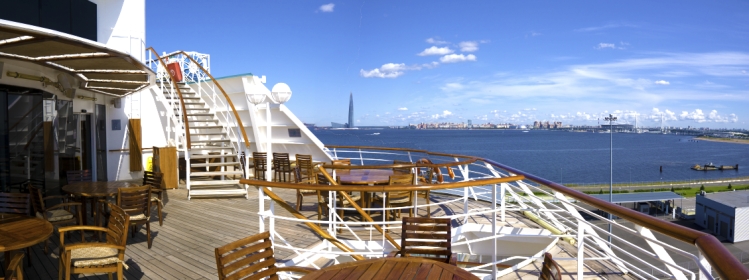
In the ship’s Bistro (a cafe for use in between formal meals, good for reading and snacking), I took two panoramas. One was a two-shot version, using the camera held in the normal horizontal position.
![]()
For the second one, I took three shots with the camera held vertically.
![]()
Both of these panoramas were shot at ISO 800 and f/2.8. The two-shot image was at 1/60th second, and the three-shot image at 1/90th second.
You can see that the vertical three-shot panorama gives you more of the floor and ceiling than the horizontal two-shot panorama.
When I am on vacation, one of the things I like to photograph is my favorite meals. This one was a lunch that consisted of Chinese food. Besides the terrific taste it had, it was also very colorful. The photo was at ISO 800, f/8, 1/350th second. Notice that even though it is at f/8, the part of the place mat near the top was out of the range of focus. This exemplifies the fact that the range of focus of objects near the camera is narrow. I was only about 10” away from the plate.
![]()
Here is a comparison of the field of view for the 16 mm lens and the 30 mm lens. Both photos were taken from the same position in my living room, f/2.8, 1/60th second, ISO 400.
First, the 16 mm lens.
![]()
And, the 30 mm lens.
![]()
You can see how useful the 16 mm lens would be for family gatherings.
On the Bench
I measured resolution at the largest aperture and at f/8.
The Sigma 16 mm lens delivered 1,289 lines per picture height at f/1.4.
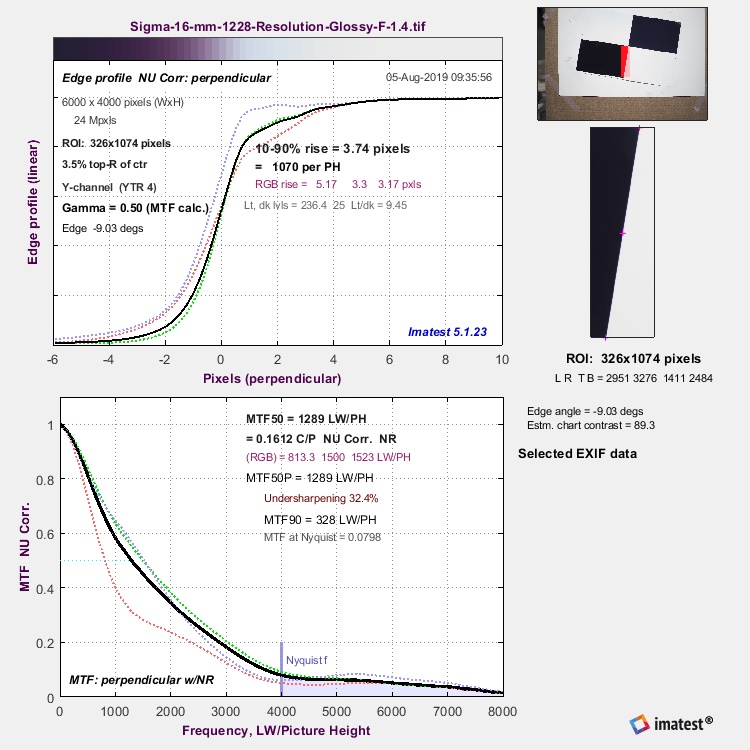
Chromatic aberration was 0.749 pixels.
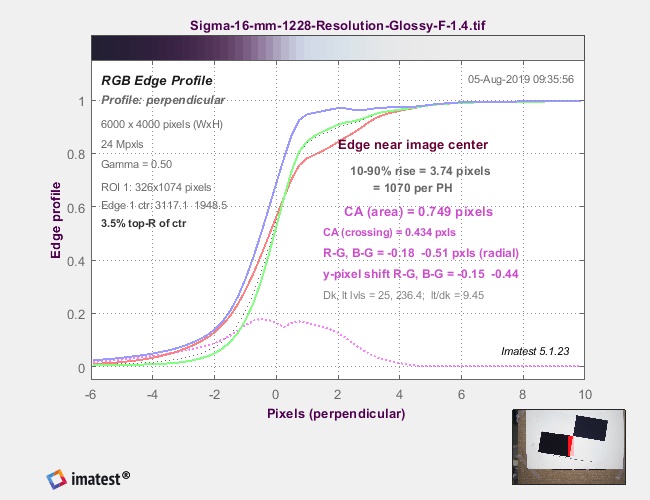
At f/8, resolution increased to 2,685 lines per picture height.
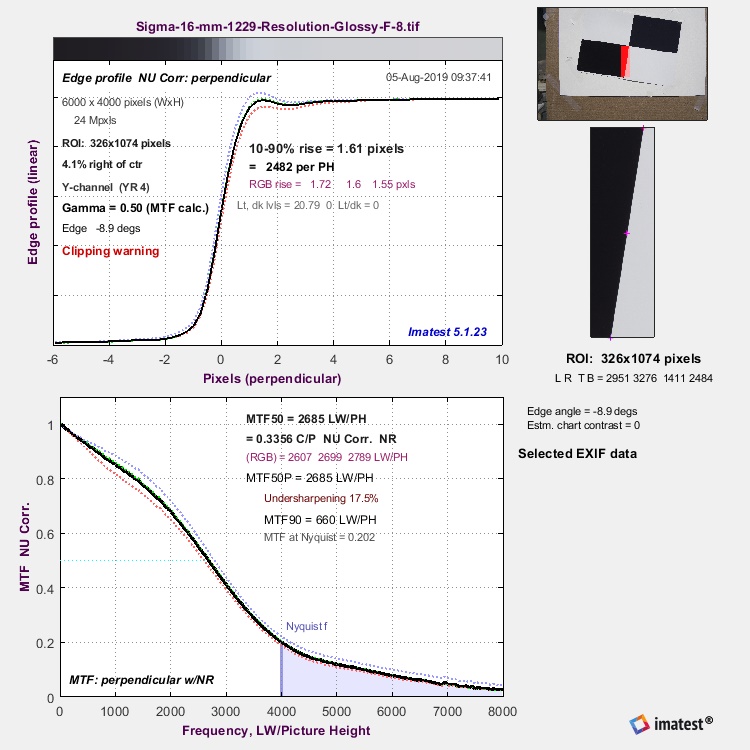
Chromatic aberration was reduced to 0.286 pixels.
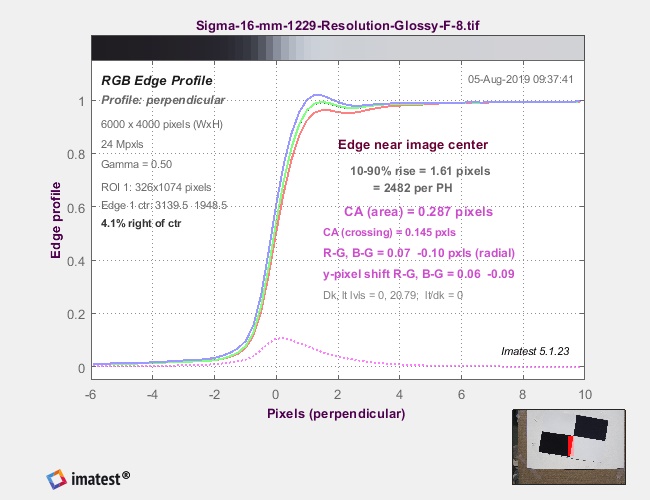
So, there is an obvious advantage in shooting at a smaller aperture. This is fine in sunlight, even at an ISO of 100. However, indoors, you need to increase the ISO in order to shoot at f/8 with a reasonable shutter speed (1/60th second) in order to reduce image blur due to camera movement during the exposure. In some cases, as shown in the photos of the Grand Hotel stairwell, you still need to shoot at a larger aperture even with the high ISO. The Sigma 16 mm lens gives you this option with its wide aperture availability.
For the 30 mm lens, the resolution was 2,828 lines per picture height at f/2.8. This is more than twice the resolution of the 16 mm lens.

Chromatic aberration was 0.0247 pixels. This is less than 1/10th the chromatic aberration of the 16 mm lens.
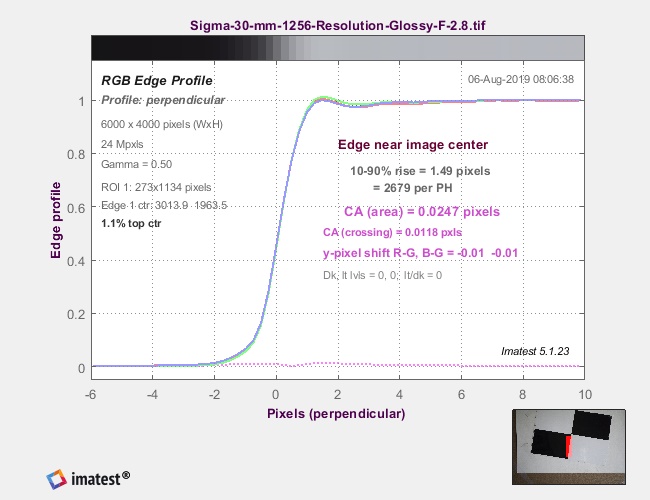
At f/8, the 30 mm lens resolution was 2,974 lines per picture height. This represents 146 lines increase in resolution over that at f/2.8.
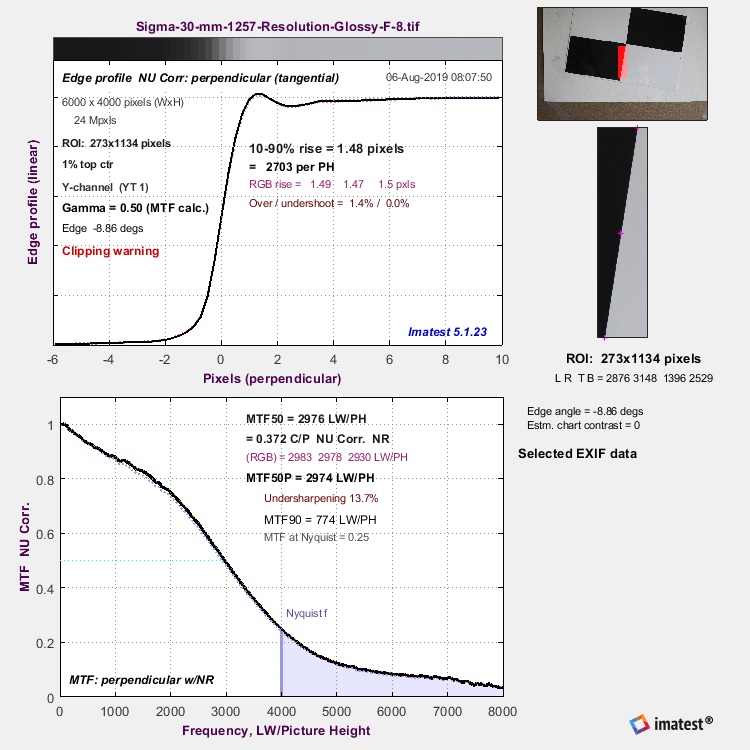
Chromatic aberration was 0.00233 pixels, which is almost no chromatic aberration at all. Truly excellent.
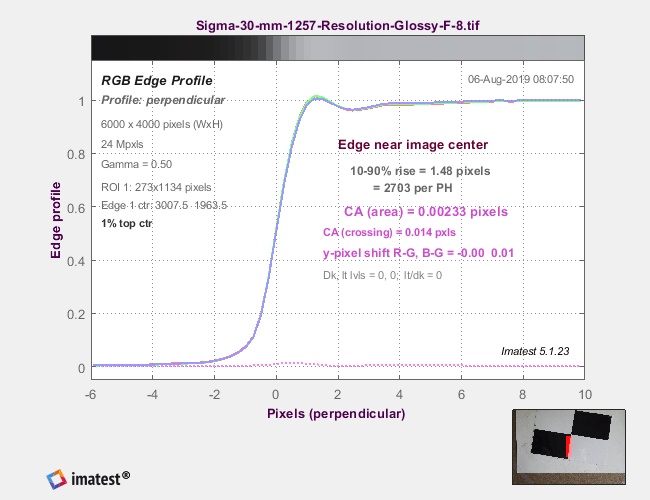
The lenses are sharp enough that you can enlarge part of the photograph and print just that section for your album. Here is test pattern taken with the 16 mm lens, f/8:
![]()
A blow-up, shown below, is from the right hand-corner of the test pattern. Notice that all the lines are sharp. This is the worst-case scenario since it is the outer edge of the photographic field where image sharpness is not as good as the center. What this means is that you can take a wide-angle photo and blow up different sections of the original photo, crop them, and have them printed at a photo album size such as 4” x 6”. With the 30 mm lens, it will be even sharper.
![]()
Vignetting in the 16 mm lens at f/1.4 is shown below.
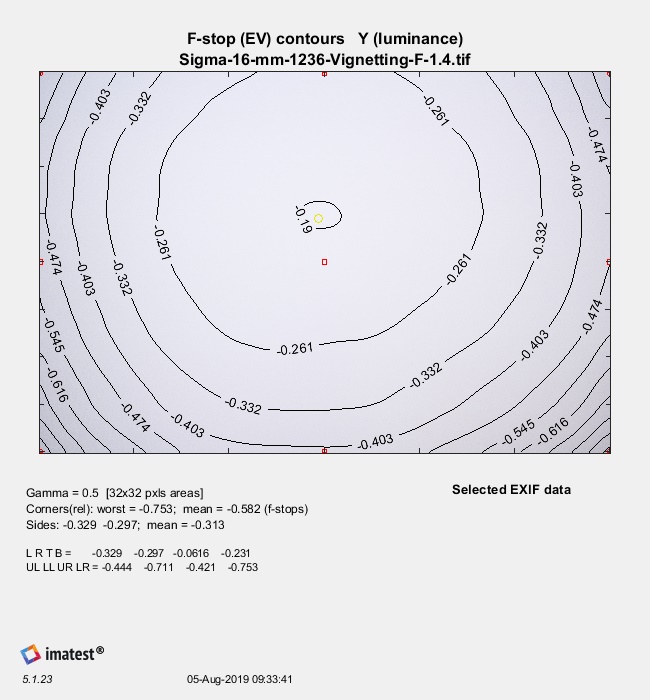
It is improved at f/8.
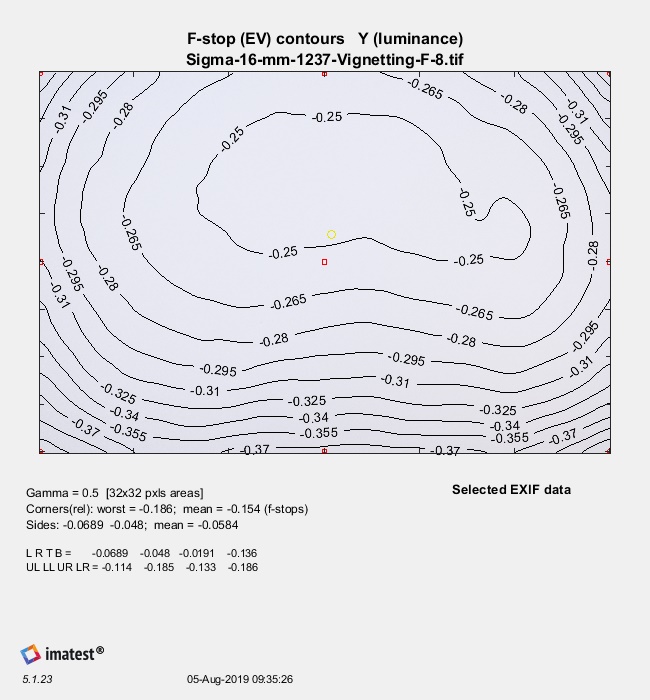
The 30 mm lens has less vignetting. Here it is at f/2.8.
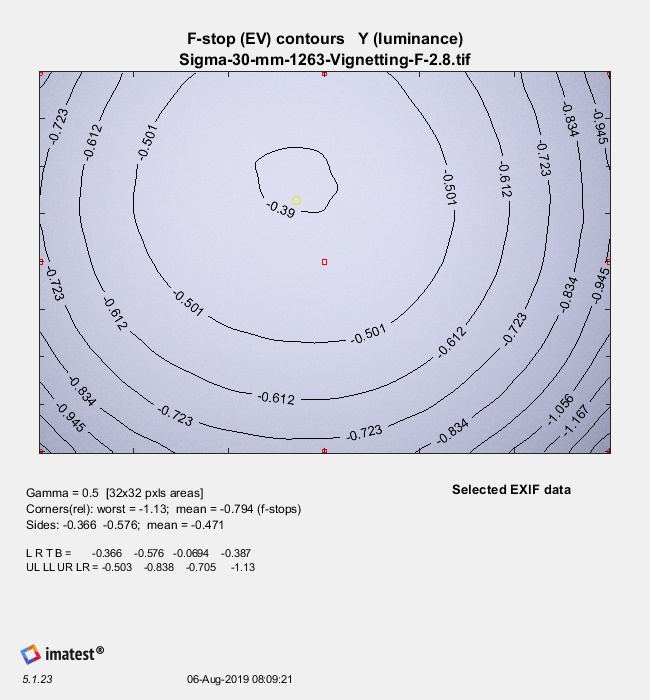
And, at f/8.
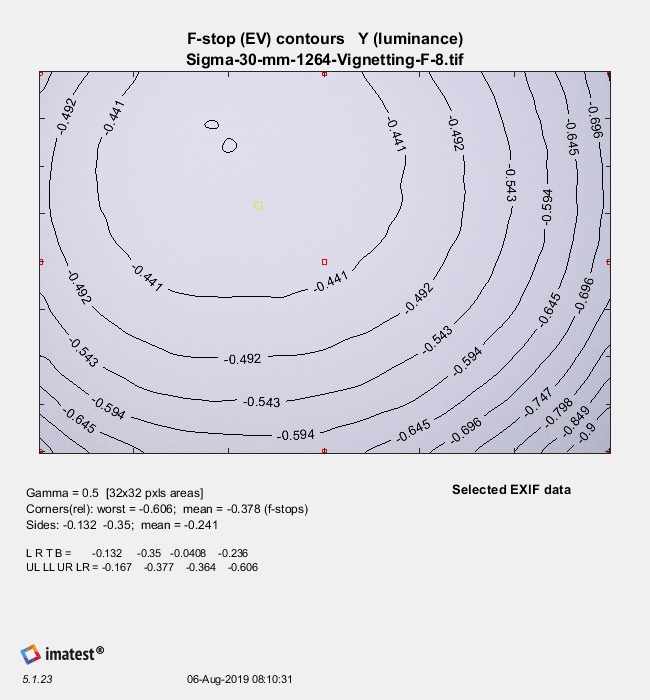
So, both lenses have vignetting. All lenses have vignetting, and it increases with decreasing focal length, i.e., wide-angle lenses have the most. However, this is easily dealt with in Photoshop Lightroom or other photo editing software.
Color saturation with the 16 mm lens is very good even at f/1.4.
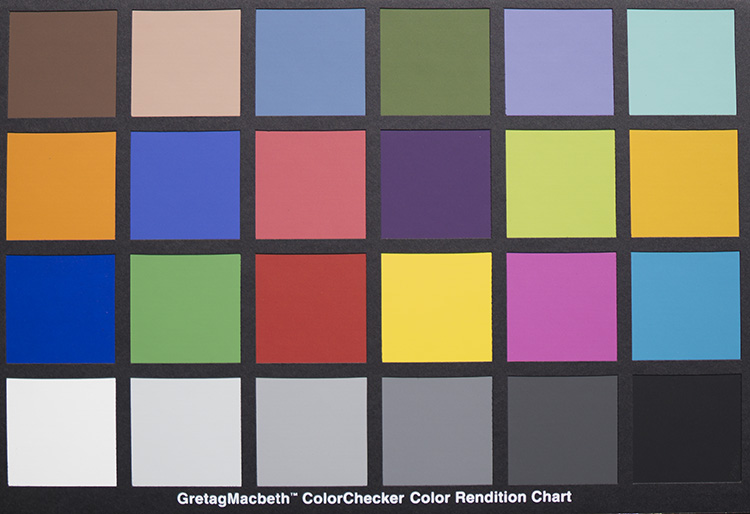
At f/8, of course, it is better.
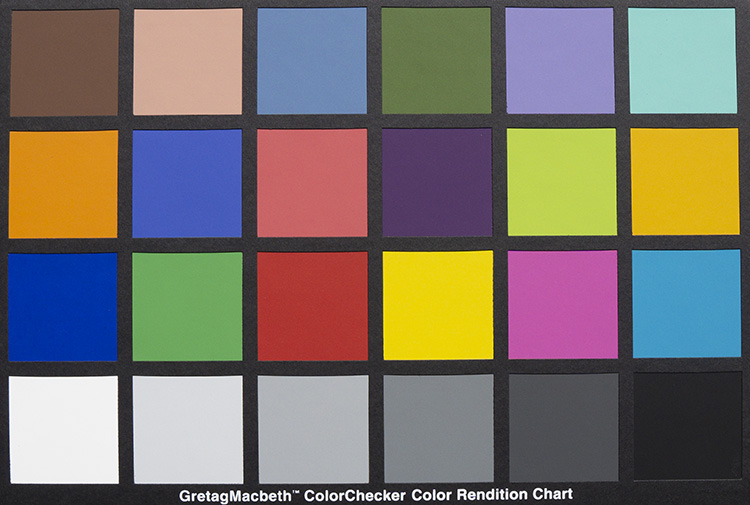
Conclusions
The Sigma 16 mm and 30 mm lenses for APS-C mirrorless cameras are very sharp. The 16 mm lens is particularly useful on vacations, especially if you use it for panoramas. At $449 MSRP, it is a no-brainer for addition to your lens kit. The 30 mm lens, which is sharper than the 16 mm lens, would be suitable for portraits.

